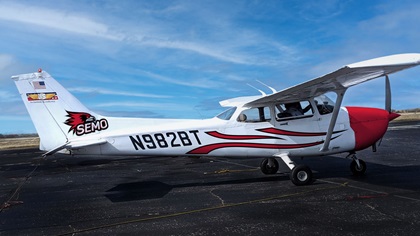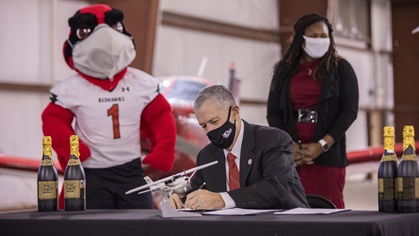Missouri university creates new professional pilot pathway
US Aviation Academy providing aircraft, flight lessons
Ken Jackson wasn’t yet an employee at Southeast Missouri State University (SEMO) when the pilot and retired Dexter, Missouri, public school superintendent pitched the university a Bachelor of Science aviation program that begins in the fall with at least 10 students pursuing a professional pilot pathway.
Jackson earned a private pilot certificate in 2017 and soon after, he approached university president Carlos Vargas—an aerospace, science, and physics expert—with the idea of establishing a four-year college aviation degree program.
Jackson said classes will begin in the fall. In-state tuition is $17,977 yearly, prior to scholarships. The “all-in” price for the professional pilot program is an additional $66,030 (excluding an optional multiengine instructor rating that costs $11,505) and includes flight training, instructor fees, aircraft rentals, simulator lessons, and checkrides. However, paying for pilot supplies like flight bags, plotters, and headsets is the student’s responsibility. Out-of-state tuition is $24,149 yearly, and students may apply for scholarships that can lower tuition to the in-state price.

The plan is for college students to participate in ground school classes at the Seabaugh Polytechnic Studies building on campus and travel a few miles south to nearby Cape Girardeau Regional Airport to learn flying skills under tutelage from US Aviation Academy CFIs.
The flight school operates a fleet of 100 aircraft nationwide and has pathway partnerships with Southwest Airlines, United Airlines, GoJet Airlines, Envoy Air, and other commercial air carriers. Students can expect to train in digital-equipped Cessna 172 Skyhawks with two Garmin G5s and a Garmin GTN 650. Spin training will be accomplished in Cessna 150/152 aircraft, and multiengine training will be in Piper Seneca twins. Because US Aviation Academy has been awarded self-examining authority by the FAA, students may save between $2,500 and $3,000 in potential checkride fees as they progress from private pilot through CFII certifications.

Jackson stressed that the school’s relationship with the flight training academy benefits both institutions. “When we open our program at SEMO in August, it will be US Aviation’s first four-year aviation program.” He added that the aviation academy has experience training students from abroad and he anticipated it could benefit the Missouri university. “We think we can attract international students at some point in the near future.”
Jackson said his involvement in flying made him realize that minorities and females are “grossly underrepresented in aviation,” so he is recruiting members of those groups and advocating for aviation careers they might not have considered. “I have a list in front of me with more than 30 aviation-related jobs,” Jackson said. “As I’ve told the students, someone has to maintain the airplanes, someone has to manage the airfield, and someone has to fly the airplanes. Corporate pilots, charter pilots, instructors—there are so many fields a student can move into” once they enroll in an aviation program. “We’re very interested in making this work.”




